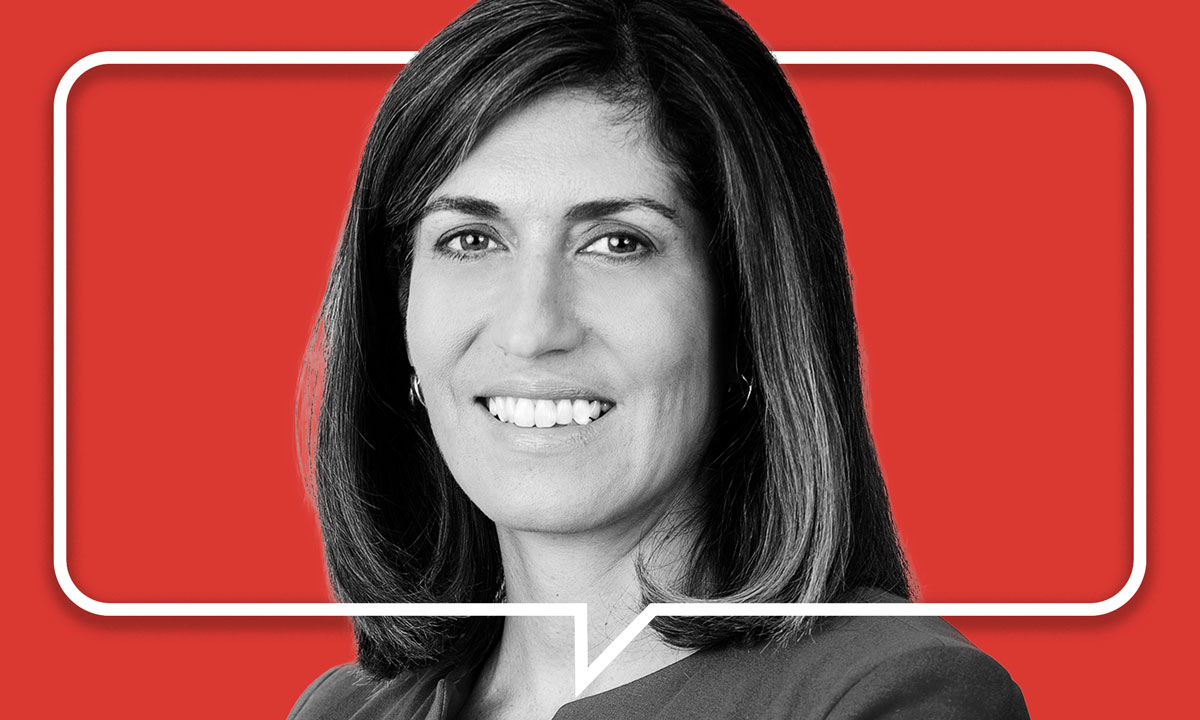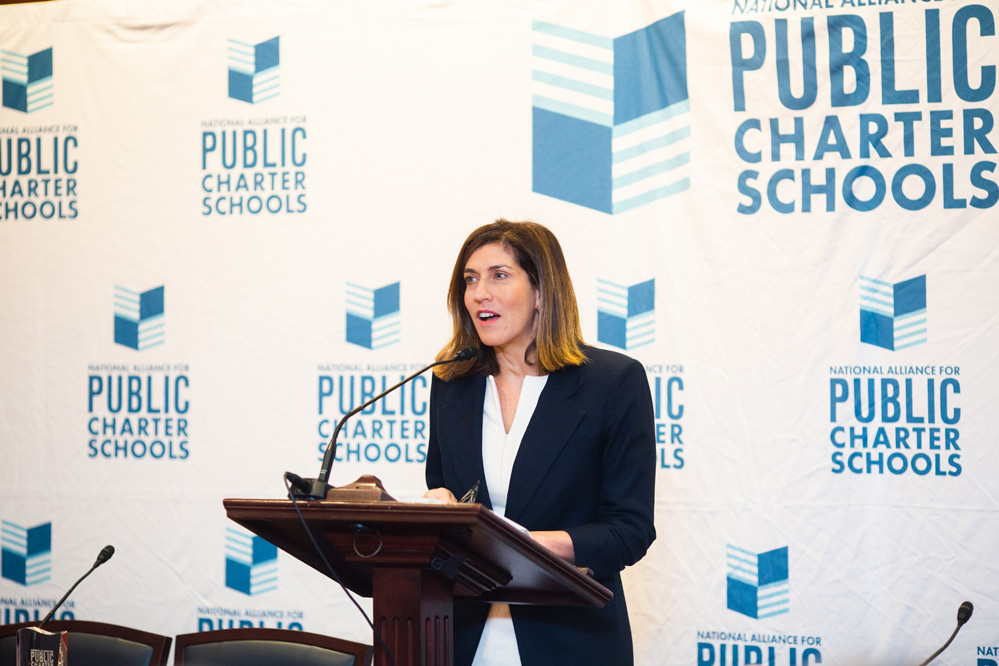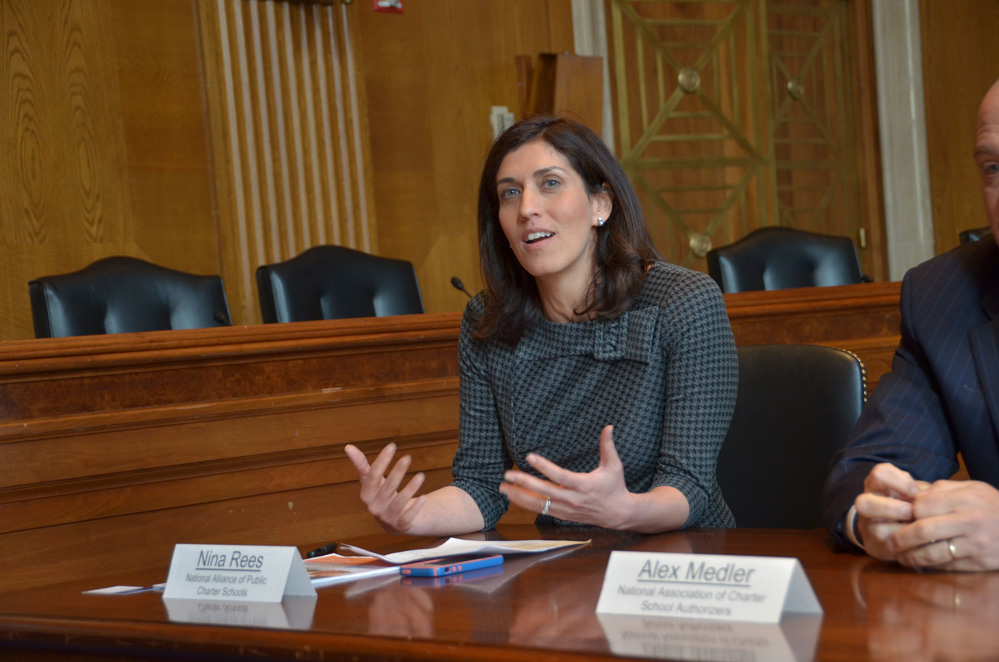‘The Center Still Holds’: In Exit Interview, Charter Leader Nina Rees Reflects on the Shifting Politics of School Choice
As she steps down from leading the sector’s advocacy group, some experts see a new ‘battleground’ ahead for movement.

Get stories like this delivered straight to your inbox. Sign up for The 74 Newsletter
Nina Rees wasn’t the first person to lead the National Alliance for Public Charter Schools. But her tenure witnessed the sector’s largest growth as well as some of the harshest attacks from critics who see charters as a threat to traditional public schools.
Her announcement last month to leave the position she’s held since 2012 comes as charter schools enter a new era — one marked by dwindling public school enrollment and an explosion of new school choice options.
Those who have studied charters see a challenging landscape ahead for the sector, which was born in Minnesota 31 years ago.
“The coming decade will see an incursion on charters from both the traditional and the new-choice side,” said Macke Raymond, founder and director of the Center for Research on Education Outcomes at Stanford University. “Nina didn’t have to cope with a double-sided battleground. The next leader will have to.”
Rees, whose family fled Ayatollah Khomeini’s regime in Iran when she was 14, was encouraged by Howard Fuller, the Alliance’s founding board chair, to apply for the president and CEO job when the organization launched in 2005. But at the time she was part of the U.S. Department of Education under President George W. Bush, working to get another school choice initiative off the ground.
She was a key figure in pushing the D.C. Opportunity Scholarship through Congress. The federally funded voucher program, which pays tuition at private schools, served about 1,700 low-income students last year, roughly half those who applied. Republicans want to increase funding for the program, while Democrats have long wanted to phase it out.

Rees, however, has left her greatest mark in the charter world.
Rhonda Dillingham, executive director of the North Carolina Association for Public Charter Schools, called Rees the movement’s “north star.”
Rees hasn’t wavered in her belief that charter schools are public and have a duty to uphold students’ civil rights — an issue that came before the 4th Circuit U.S. Court of Appeals last year. A North Carolina charter school argued that it should be able to enforce a strict dress code including skirts for girls just because it was run by a nonprofit.
And Michael Petrilli, president of the conservative Thomas B. Fordham Institute, said Rees and the Alliance have been “hawks” on the issue of low-performing virtual charter schools, calling on authorizers in 2015 to “dramatically improve oversight of their schools, which, in some cases, will mean closing them.”
As Raymond noted, whoever replaces Rees at the Alliance will face new obstacles. Education savings accounts, which pay for private school tuition and homeschool expenses, have rapidly expanded in multiple states, giving families more options outside of the public education system. And as the North Carolina case, Peltier v. Charter Day School, raised, there’s an ongoing debate over whether charters are public or private under the law. Those who say charters are private argue there should be no limits on religious organizations running schools. The fate of a virtual Catholic charter in Oklahoma, set to open in the fall of 2024, is now tied up in court.
“The notion of charters being considered private … is something that we will fight,” Rees said in a recent conversation with The 74.
She’s also persistently fought for increased funding for the federal Charter Schools Program and pushed hard last year against the Biden administration’s efforts to make it more difficult to apply for that money. She argued that the administration didn’t seek input from sector leaders when writing the rules.
The new regulations call for charters to be more racially balanced and for operators to gain support from traditional schools, which can be difficult when there is competition for students. Organizers also need to avoid opening in neighborhoods where district schools are losing enrollment.
The new rules were also intended to create more transparency when charter funds flow to for-profit companies. They drew support from critics who argue that the involvement of for-profit businesses in operating charters — especially virtual schools — creates the potential for fraud.
Rees’s leadership of the sector’s principal advocacy organization has coincided with increased quality. CREDO’s most recent report showed students in charters, particularly those in large networks, slightly outperform their peers in traditional schools.
In the interview, Rees spoke about those findings, the shifting political environment on school choice and her future interest in helping others realize, as she did, opportunity in America.
This conversation has been edited for length and clarity.
The 74: Why leave now?
Nina Rees: With anyone who’s been working in an organization, after 10 years you start to evaluate if you want to stay for another five or 10 or if it’s time to move on. I have accomplished a lot of the things I set out to do. When I came to this organization the Charter Schools Program was only getting $254 million and different charter groups were fighting with one another to capture a portion of that pie. Increasing the pie united the sector and made sure that everyone receives something from the federal grant. The funding is at $440 million. I was hoping it would hit $500 million, but $440 million is a good place to be.
The other goal was to get charters in 50 states — we are now at 46 — and just to stabilize the organization as a hub of information for the sector. I’ve gone through three different administrations, from President Obama to President Trump and now to President Biden. That’s a lot of turmoil, with the pandemic in between. I think it’s time for some fresh thinking. Post-pandemic, we have some huge opportunities to seize because so many families continue to want options. Charter schools have a role to play in meeting that demand.
You’ve seen political support for charters shift dramatically during your tenure with the Alliance. Without the bipartisan base as strong as it once was, did your job become more difficult?
It was getting difficult to navigate when I came, but I’d like to answer this question differently. In the latest Democrats for Education Reform poll, and every poll that we’ve seen over time, Democrats support choice and charter schools in particular. At the top level, there’s not as much discussion around charter schools in a bipartisan way. The education reform debates are no longer as central as they used to be, with the pandemic shifting attention to other priorities. The Democratic and Republican parties are fraying and the opposite ends are getting more airtime, but the reality is that the center still holds. It’s in the center where policy is made. So regardless of the Matt Gaetzes and the [Alexandria] Ocasio-Cortezes, most of what’s happened over the past decades since I’ve been at the federal level has been bipartisan, with the support of Democrats like Cory Booker and Michael Bennet and Republicans like Virginia Foxx.

It seems Republicans are more focused on expanding education savings accounts than they are charters. How do you see that playing out at the state level?
We’re monitoring to see how those ESA laws are being implemented. But there was also a lot of momentum around charter schools. Post pandemic, we saw a slew of legislative activity, from revolving loans to access to facilities to huge improvements in states like Arkansas. Even New York found a way to allow for charter school expansion.
ESAs are new and more controversial. They get more media attention, and these other measures, which are amendments to existing laws, are not getting as much airtime. Once the history books are written, people are going to look at these years as pivotal for charters.

And how do you see the growth of ESAs affecting the charter sector?
In most of these states, it looks like they’re just subsidizing the tuition of private schools students already attend. But in those places where the allocation for the ESA is on par or potentially a little bit higher than what students in charter schools get, that’s where we might want to study and see if there are any shifts.
One of the biggest charter school stories of the year — and in education in general — has been the Catholic virtual charter school application in Oklahoma. What are your predictions for the debate over religious charter schools?
Let’s go back to where we were about six months ago when the Peltier case was pending before the Supreme Court. We were questioning whether that case [which asked whether charters were public or private] would pave the way for religious charter schools. The court chose not to take the case and we’re very pleased with that. For charters to be able to teach religion, you need a proactive statement that deems them private, and that is a point of contention. Everyone who has drafted a charter law and everyone involved in conceptualizing charter schools created these schools in order to create better public schools.
In school choice circles, we sometimes hear the message that parent satisfaction is the most important measure of success. Do you feel that there’s been a shift away from holding charters accountable for results? Did the pandemic play a part there?
That’s a great question. I do think we need to take stock of the accomplishments before we pivot to the flaws in the equation. The first time Macke Raymond of CREDO did the study, we weren’t doing that well. The second time, it was a little bit better. The third tranche of her study definitively demonstrates that the longer our school leaders are in this work, the better they do by the students they’re serving.
There’s always been debate around whether standards-based accountability and standardized tests get in the way of innovation and potentially harm those types of schools that serve special populations. Over time, state accountability systems have adjusted so they’re not inadvertently discouraging the creation of a credit recovery school or a school that serves a student population that is way behind academically.
Paying attention to what parents want is very important, and I know that the choice movement is talking a lot more about that. But at the end of the day, the compact with the authorizer is very important. That’s where the rubber hits the road. If charters are not performing well or meeting the terms of their contract, they should be closed.
I don’t know any parents who want to send their child to a school that is not going to graduate them and send them to college.
Along with ESAs, we also see more microschools emerging that are responding to very specific needs and preferences for families. Do you see those models impacting charters?
This is an opportunity for charter schools. When you notice that people have an affinity or an interest in smaller settings that are offering a more customized education, this means charter management organizations can create some of these and see how it works without letting go of all the other things that we need to do as public schools. In the private sector, if there’s an interest to buy certain things, companies start to compete. The charter sector can also create models that are just as attractive but keep the core of what is public about public education.
Charter enrollment saw a big jump during the pandemic and leveled off a bit last year. How do you think the general decline in public school enrollment we’ve seen nationally is affecting charters?
Our enrollment report is coming out in November, so stay tuned. We’re pretty excited about it. That’s the only thing I can say.
There are two things going on. One is that populations are shifting. This is why we’re so excited about Montana having passed a charter law and the fact that in Arkansas, you can now open a charter school anywhere around the state. States have made changes that allow charters to open in jurisdictions where populations are shifting.
People are just dispersing more and that presents a challenge. If you have a model in one community, it’s quicker to scale it and add more students. But if you’re going into these more suburban and rural communities, it’s a little bit more challenging to take this work to scale. For me, it’s going back to the basics; charter schools were always supposed to be about giving local community leaders the tools they need to start something new and different. This opens the door to innovation in ways that are good for the sector.
You’re not sure what you’re doing next, but what would you like to do?
I love this topic of choice and charters, but I also am fascinated with polling around the American dream. I’d like something that combines what I’ve done here with adding to the hope and the opportunity of the American dream, with education being one of the key pillars. I like this sector because it invites innovation and big-picture thinkers who are willing to overcome the impossible. Whatever I do next hopefully will continue to be with individuals in service to something that’s transformational.
Get stories like these delivered straight to your inbox. Sign up for The 74 Newsletter

;)
